Looking at the abnormal bulge in your abdomen and getting panicked about it? Relax, it is not a tumor but it may well be a Ventral Hernia, an unnatural protrusion in the abdomen.
What is a Ventral Hernia?
Page Contents
There is as such, no clear Ventral Hernia Definition for you. A Ventral Hernia is normally described as a hernia, or a protrusion of an organ inside the abdomen such as the intestine or the bowel. In normal circumstances, the surrounding muscles and body tissues keep a organ inside the cavity. But in case of Ventral Hernia, the protruded organ comes out through the cavity and pushes the abdominal wall. The protrusion is visible from the outside in the form of a bulge in the abdomen. The condition is curable but quite difficult to treat. It causes much discomfort in a person.
Ventral Hernia Symptoms
Ventral Hernias are characterized by a lot of symptoms, which can be external as well as internal. These are :
Pain
Ventral Hernias are normally painless and even touching the bulge causes no ache in the sufferer’s body. But incarcerated hernias can cause much pain. These are protrusions that fail to enter back into the original cavity that they come out from. In acute cases, necrosis may take place. Blood supply to the protruded part is cut off and the organ tissues die due to lack of nutrition. This leads to a case of strangulated hernia, causing much pain to the sufferer.
Patients with Ventral Hernia experience pain especially during strain, such as while coughing or lifting heavy objects.
Bulge
The protruded organ is visible as a bulge in the sufferer. It remains viewable even when the patient is lying down.
Nausea
Incarcerated ventral hernia can cause serious bodily discomfort to the sufferer. The person may experience nausea due to this reason.
Vomiting
The nauseating feeling in Incarcerated hernia sufferers can also make them vomit.
No bowel Movement
Patients with Incarcerated hernia conditions often suffer from an inability to have a bowel movement.
Tenderness
Patients may often experience tenderness in the affected area of the abdomen.
Enhanced Heart Rate
The heart rate may often increase in sufferers with stomach hernia condition causing much discomfort.
Growing Bulge
When the patient has an incisional hernia condition, the bulge may grow bigger in size with passing time. Ventral Incisional Hernia occurs when an old surgical wound of a person does not heal properly.
What causes Ventral Hernia?
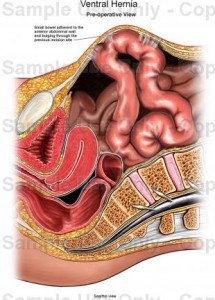
Picture 1 – Ventral Hernia
Source – biotechfordummies
Ventral Hernias may develop due to a number of reasons. A lot of system disorders may contribute to give rise to herniation inside the abdomen. The common causes for Ventral Hernia development are
Weakening of Abdominal Walls
When the walls of the abdominal cavity become weaker, it may lead to herniation.
Infected Surgical Wound
A Ventral Hernia may also occur if a surgical wound in the body of a person gets infected after operation.
Hematoma
If a blood clot forms in the area where a surgical incision took place, it may also give rise to a hernia.
Malnourishment
In some cases, the operated area does not heal due to malnourishment. This may be due to lack of blood supply in the area due to some cause.
Tearing of Stitches
If a newly stitched area undergoes strain, the stitches may open. The area may start bleeding and it can also get infected. This can cause a hernia.
Obesity
Increased body fat often makes healing of an operated area more difficult. This again, can cause a rupture in the smooth muscle tissue.
Age
Aged people find it very difficult to heal after stitches. Unhealed surgical wounds can lead to hernia.
Coughing
Intense coughing can cause a tear in the surgical stitches and reopen wounds. This can lead to infection and herniation.
Ventral Hernia Treatment
Ventral Hernia is a serious condition and it is best to get it treated as soon as possible. If there is a case of more severe condition, such as Strangulated Hernia, an immediate medical treatment is required.
Medical Ventral Hernia Treatment
The treatment of the condition generally involves Ventral Hernia repair through operation. Most cases of Ventral Hernia treatment require Ventral Hernia surgery. The surgical method may be
Abdominal Ventral Hernia Operation – The purpose of the surgical operation is to support the abdominal muscles and replace the protruding organs. The Hernia operation is known as Herniorrhaphy. A large incision is made in such operations and the recovery usually takes much long time.
Laparoscopic Ventral Hernia Repair – The repairing is done by using laparoscopes, or small cameras. A small incision is made through which the camera and instruments are inserted and used for operation.
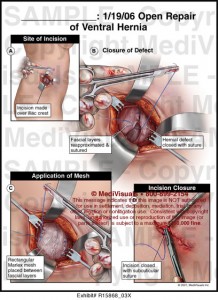
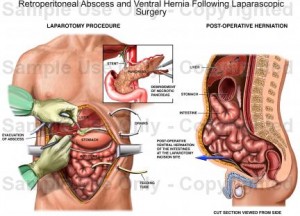
Picture 2 – Ventral Hernia Surgery Picture 3 – Ventral Hernia Surgery
Source – medivisuals Source – nucleusinc
The patient is usually advised some lifestyle changes following the operation for quick recovery. The sufferer is also advised to take precautions against respiratory infections that may cause sneezing or coughing, which may put strain on the stitches and open the wound.
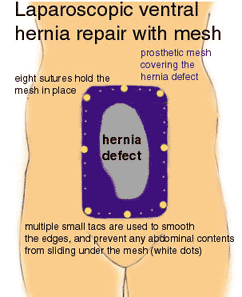
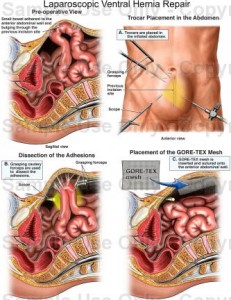
Picture 4 – Ventral Hernia Repair with Mesh Picture 5 – Laparoscopic Ventral Hernia Repair
Source – lapsurg Source – doereport
In some cases, doctors carry out Ventral Hernia repair with mesh or synthetic material. Meshes are used to hold the weakened tissues in place and prevent them from rupture by stretching. This is known as a “Tension free” method of muscle repair.
Ventral Hernia Treatment at Home
The treatment of the condition can be aided by following some simple steps at home. These include :
- Incorporating high fiber foods into the diet and drinking more fluids. This will prevent constipation.
- Avoid smoking.
- Regular exercise. Lifting weights should be done wearing supportive garments.
Ventral Hernia Pictures
Ventral Hernias are often difficult to understand for people from non-medical background. Here is a collection of pictures on Ventral Hernia that will help you know the condition better. If you have an abdominal bulge and suspect it to be a Ventral Hernia, you can check out these pictures to make sure.
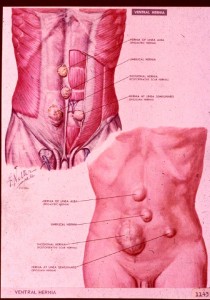
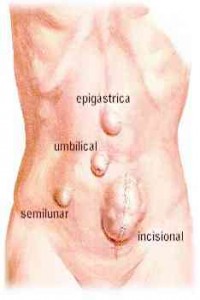
Picture 6 – Ventral Hernia Picture 7 – Ventral Hernia
Source – fnu.ac.fj Source – arcticboy
Ventral Hernia is a serious condition that may give rise to severe, life-threatening symptoms. If you detect a bulge symptomatic of Ventral Hernia in yourself or anyone you know, get immediate medical attention. This will help you enjoy good health and avoid a lot of future complications.
References:
http://www.healthscout.com/ency/68/305/main.html
http://en.wikipedia.org/wiki/Hernia
http://www.wrongdiagnosis.com/v/ventral_hernia/symptoms.htm
http://www.wisegeek.com/what-is-a-ventral-hernia.htm
http://www.medicinenet.com/hernia/article.htm
http://www.medscape.com/viewarticle/724450

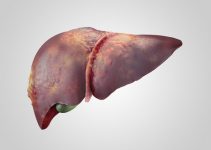
I found your information on ventral hernia very informative, however, right inthe middle of the information is an ad for South BeachDiet and it cannot be removed and blocks the paragraph text. Very irritating. You may want this but if you do not, take a look –
The information was quite informative for me. Sometimes, our Doc’s don’t go into much detail. The material’s pictures were helpful. No real negatives at this time.
I had ventral hernia repair done on May 2, 2011 and I am now have a lot of sharp pain over the area that the surgery was done. I had a lap. with the mest under and attached with perm stitches.
i’m getting ready to have the surgery within the next 30-45 days…BUT, i am taking subutex. will this be a problem as you know what this drug does. will the pain medications DURING SURGERY cause me any problems that can be a serious consequence ? please anyone?
Being over 76 my doc/surgeon recommended avoiding incisional surgery. (He did not offer laproscopy). The infection risk and recovery problems along with COPD made it not worth the risk. Instead he recommended a semi-permanent support belt option. It may not be totally comfortable but there’s little risk of side-effects and it is not needed at night.
I Just had an incarcerated ventral hernia repair one week ago. My symtoms included major pain & tenderness, no appetite, loss of bowel movements, fever & nausea. I was advised by my Dr to go directly to ER & had emergency open repair surgery less than 3 hrs after arrival. My incision was closed with staples & my hospital stay was 3 days. The hernia was repaired with mesh & is still very painful & my appetite is still very poor. There is pain & redness at the incision site.
Subutex blocks the effects of opioid pain medication. Because of this controlling your pain may be a problem. You need to discuss your options with your Dr prior to your surgery.